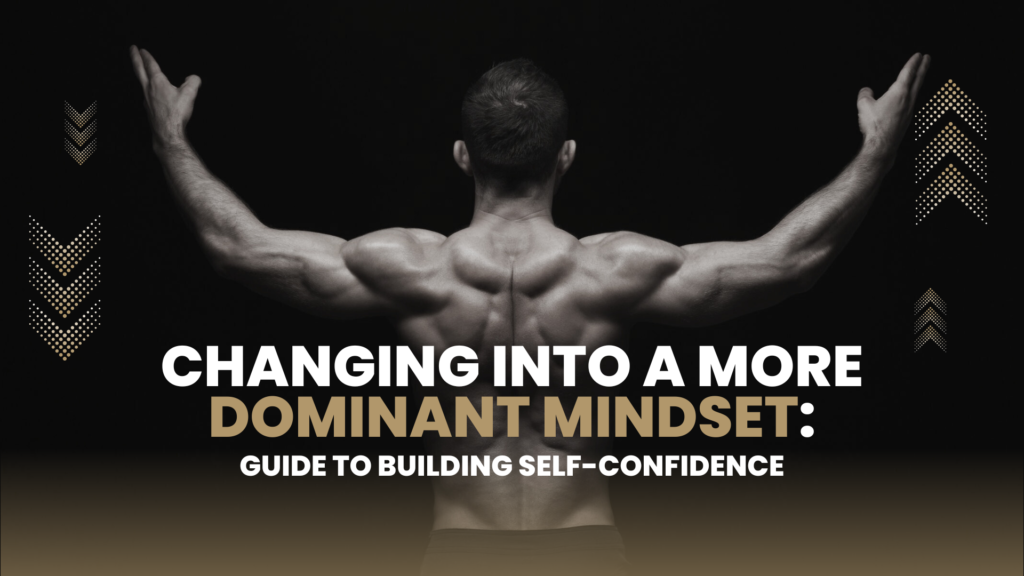Developing a dominant mindset is a powerful way to improve your self-esteem, increase success in various areas of your life, and overcome obstacles holding you back. A prevailing mindset involves having a solid sense of self-confidence and assertiveness and overcoming challenges and setbacks. This blog post will explore how to change into a more dominant mindset by building self-confidence. We will begin by defining a prevailing mindset and why it is essential. Then, we will delve into the importance of building self-confidence to develop a dominant perspective. Understanding how self-confidence is linked to a prevailing mindset will provide a foundation for developing effective strategies to build confidence and change your mindset for success.
Understanding Self-Confidence
Self-confidence is a critical component of developing a dominant mindset. It is a belief in oneself and one’s abilities to handle situations and overcome obstacles. In this section, we will discuss the definition of self-confidence, the characteristics of self-confident individuals, and the importance of self-confidence in building a dominant mindset.
Definition of Self-Confidence
Self-confidence is the belief in one’s abilities, qualities, and judgment. It is a positive feeling that comes from within and does not depend on external factors. Self-confident individuals trust their judgment, feel comfortable in their skin, and are not easily swayed by the opinions of others. As a result, they have a strong sense of self-awareness and self-esteem.
Characteristics of Self-Confident Individuals
Self-confident individuals possess several characteristics that set them apart from those who lack confidence. These characteristics include:
- Self-confident individuals have a positive self-image and are comfortable with who they are. They do not feel the need to conform to the expectations of others.
- Ability to take risks: Self-confident individuals are unafraid to take risks and try new things. They know that failure is a part of the learning process and are not deterred by setbacks.
- Assertiveness: Self-confident individuals are assertive and can communicate their needs and wants effectively. They are not afraid to stand up for themselves and set boundaries.
- Resilience: Self-confident individuals are resilient and can bounce back from setbacks. They do not let failure define them and use it as a learning opportunity.
Importance of Self-Confidence in Building a Dominant Mindset
Self-confidence is a critical component of developing a dominant mindset. It provides the foundation for assertiveness, resilience, and taking risks. Conversely, a lack of self-confidence can hold individuals from achieving their goals and reaching their potential. It can also lead to feelings of inadequacy and self-doubt, hindering personal and professional growth.
Developing a dominant mindset requires building self-confidence. Self-confidence is the belief in oneself and one’s abilities. It is essential for extending the characteristics of a prevailing attitude, such as assertiveness, resilience, and the ability to take risks. The following section will discuss building self-confidence to develop a dominant mindset.

How to Build Self-Confidence
Self-confidence is essential to developing a dominant mindset; building it takes time and effort. This section will discuss several strategies for building self-confidence that can help create a prevailing attitude.
Identifying and Challenging Negative Self-Talk
Negative self-talk can be a significant obstacle to building self-confidence. It can lead to self-doubt and inadequacy and hinder personal growth. One strategy for building self-confidence is to identify and challenge negative self-talk. To do this:
- Start by paying attention to the thoughts that go through your mind.
- When you notice negative self-talk, challenge it by asking yourself if it is accurate and if there is evidence to support it.
- Replace the negative thought with a positive one.
Recognizing and Building on Strengths
Another strategy for building self-confidence is to recognize and build on your strengths. Everyone has unique strengths and talents, and recognizing them can help boost confidence. This can help build a sense of competence and self-assurance.
Setting and Achieving Goals
Setting and achieving goals is an effective way to build self-confidence. It provides a sense of accomplishment and can boost self-esteem. Start by setting small, achievable goals, and gradually work up to larger ones. Then, celebrate each achievement, and use it as motivation to keep going.
Practicing Self-Care and Self-Compassion
Practicing self-care and self-compassion is crucial to building self-confidence. Taking care of yourself physically, mentally, and emotionally can help you feel more confident and capable. This can include getting enough sleep, eating well, exercising regularly, and engaging in activities that bring you joy. Additionally, practicing self-compassion can help you be kinder to yourself and reduce feelings of self-doubt and inadequacy.
Building self-confidence is a crucial step in developing a dominant mindset. Strategies such as identifying and challenging negative self-talk, recognizing and building on strengths, setting and achieving goals, and practicing self-care and self-compassion can help build self-confidence and develop the characteristics of a dominant mindset. The following section will discuss strategies for creating a prevailing mindset.
Strategies for Developing a Dominant Mindset
Developing a dominant mindset is about having the confidence, determination, and resilience to pursue your goals and achieve success. It involves a mindset shift from one of self-doubt and fear to one of self-assuredness and conviction. This section will discuss several strategies for developing a dominant mindset.
- Embracing Failure as an Opportunity to Learn and Grow: One of the critical characteristics of a dominant mindset is the ability to embrace failure as an opportunity to learn and grow. Instead of letting failure hold you back, view it as a stepping stone toward success. Use failure to learn from your mistakes and improve your skills. Adopting a growth mindset can help you develop this perspective and build resilience and perseverance.
- Practicing Assertiveness and Boundary-Setting: Practicing assertiveness and boundary-setting is essential to developing a dominant mindset. Being assertive means standing up for yourself, communicating your needs and desires clearly, and setting boundaries with others. It involves being confident and standing by your decisions, even in the face of opposition. This can help you gain respect and authority personally and professionally.
- Focusing on Solutions Rather than Problems: A dominant mindset involves focusing on solutions rather than problems. Instead of dwelling on challenges or obstacles, focus on overcoming them. This requires a positive attitude, a creative mindset, and thinking outside the box. In addition, focusing on solutions allows you to develop a sense of agency and control over your life.
- Cultivating a Growth Mindset: Cultivating a growth mindset is crucial to developing a dominant mindset. A growth mindset involves believing your abilities can be acquired through hard work and dedication. It consists in embracing challenges and viewing setbacks as opportunities for growth. Adopting a growth mindset can develop resilience, perseverance, and a sense of purpose.
Developing a dominant mindset is about adopting attitudes and behaviors that help you pursue your goals and achieve success. Strategies such as embracing failure as an opportunity to learn and grow, practicing assertiveness and boundary-setting, focusing on solutions rather than problems, and cultivating a growth mindset can help you develop the characteristics of a dominant mindset. By building self-confidence and developing a prevailing mindset, you can become the best version of yourself and achieve your goals.
Overcoming Obstacles to Building Self-Confidence and a Dominant Mindset
Building self-confidence and developing a dominant mindset can be challenging. Many obstacles, such as self-doubt, imposter syndrome, criticism, rejection, setbacks, and failures, can arise. This section will discuss strategies for overcoming these obstacles and continuing to build self-confidence and a dominant mindset.
- Dealing with Self-Doubt and Imposter Syndrome: Self-doubt and imposter syndrome can significantly hinder building self-confidence and a dominant mindset. It’s essential to recognize that these feelings are common, and everyone experiences them at some point. Reframing negative self-talk is one strategy for dealing with self-doubt and imposter syndrome. When you hear that little voice telling you you’re not good enough, challenge it by asking yourself, “Is this thought true? What evidence do I have to support it?” Focus on your strengths and accomplishments instead of your weaknesses and failures. Talking to someone you trust about your feelings and getting their perspective can also be helpful.
- Navigating Criticism and Rejection: Criticism and rejection can be difficult to handle, but they are inevitable. One strategy for navigating criticism and rejection is to learn from them. Ask yourself, “What can I learn from this feedback? How can I use it to improve?” It’s important to remember that constructive criticism is meant to help you grow and develop, not tear you down. Rejection can also be an opportunity to learn and grow. It can help you identify areas for improvement and motivate you to work harder to achieve your goals.
- Coping with Setbacks and Failures: Setbacks and failures can be discouraging, but they are opportunities to learn and grow. When you experience a setback or failure, taking a step back and assessing the situation is essential. Ask yourself, “What went wrong? What can I do differently next time?” It can also be helpful to talk to someone you trust and get their perspective. Remember that setbacks and failures are a natural part of the learning process. Don’t give up, keep trying, and remember that success often comes after multiple failures.
Building self-confidence and developing a dominant mindset requires persistence, resilience, and a willingness to face obstacles head-on. By learning to deal with self-doubt and imposter syndrome, navigating criticism and rejection, and coping with setbacks and failures, you can overcome these obstacles and continue to build a dominant mindset. Remember that building self-confidence and developing a dominant mindset is a journey, not a destination. Keep working towards your goals, and you will see progress over time.
Building self-confidence and a dominant mindset is essential for achieving success in all areas of life. By cultivating a strong self-belief, you can overcome obstacles, achieve your goals, and lead a fulfilling life.
Throughout this guide, we’ve discussed the importance of self-confidence and a dominant mindset and strategies for building them. We’ve also explored some of the obstacles that can arise and how to overcome them.
Remember that building self-confidence and a dominant mindset is a journey, and it’s okay to experience setbacks and failures along the way. The key is to stay committed to your goals and continue to work towards them. With persistence and resilience, you can develop a strong sense of self-belief and achieve your full potential.
So, if you’re ready to start building self-confidence and a dominant mindset, take action today. Identify areas where you can challenge negative self-talk, recognize your strengths, set achievable goals, practice self-care and self-compassion, embrace failure as an opportunity to learn, practice assertiveness and boundary-setting, focus on solutions rather than problems, and cultivate a growth mindset.
By taking these steps, you can develop the self-confidence and dominant mindset you need to achieve your goals and live the life you want. Remember, you have the power to take control of your mindset and your life. So, what are you waiting for? Start building your self-confidence and dominant mindset today!





